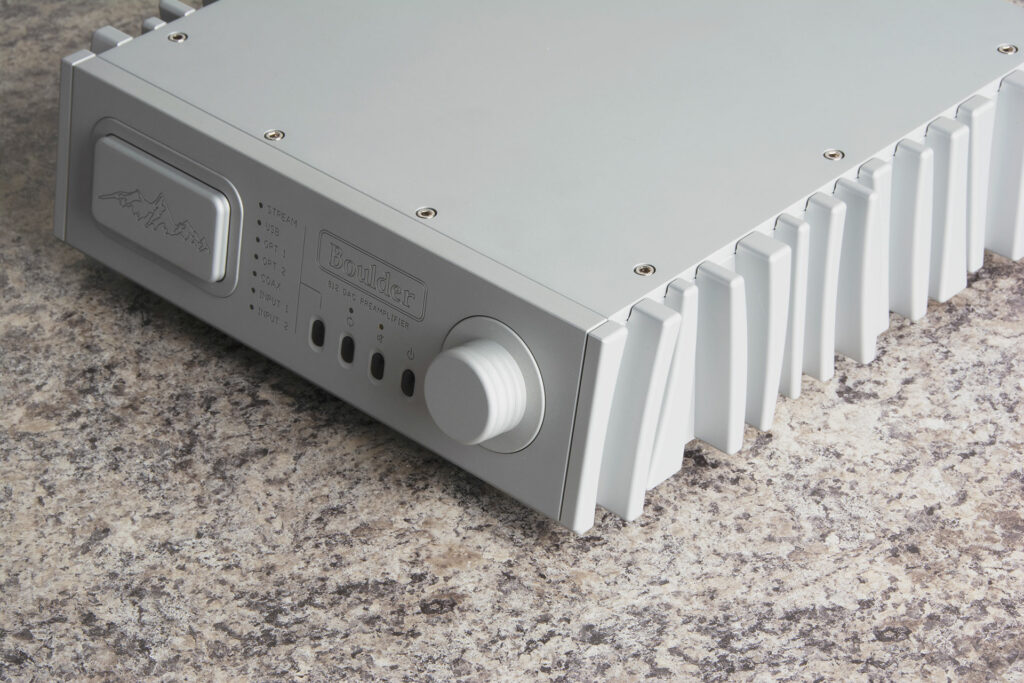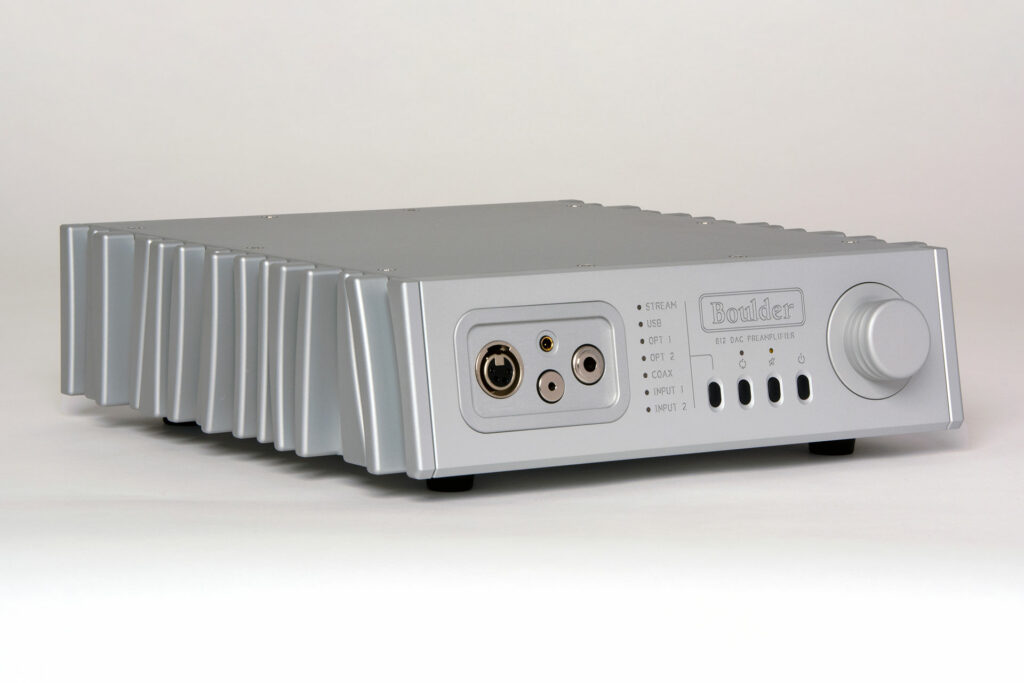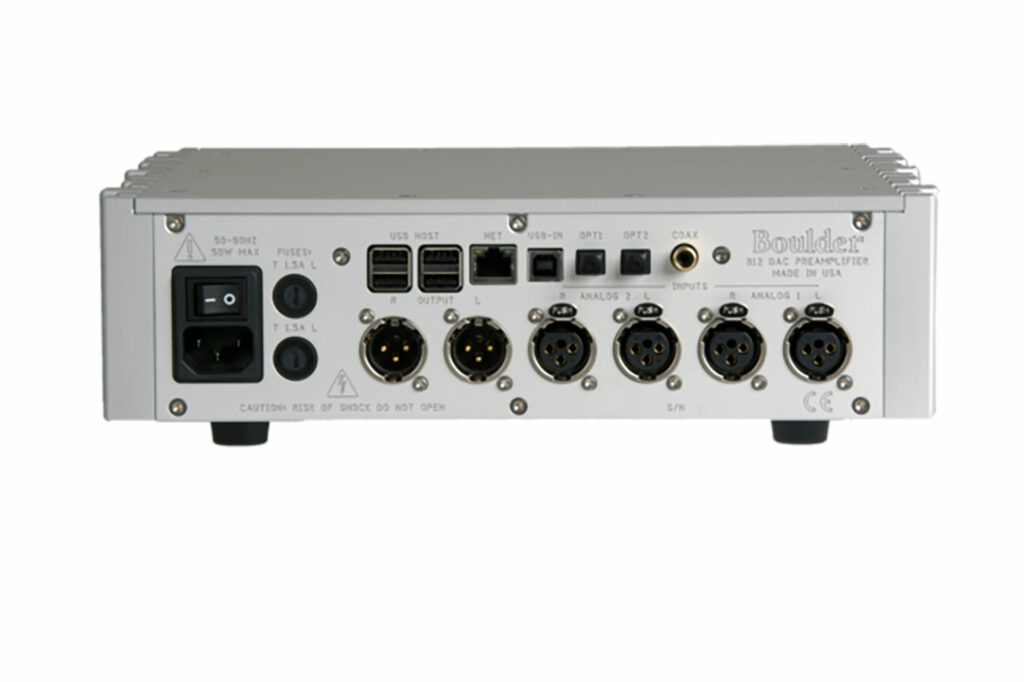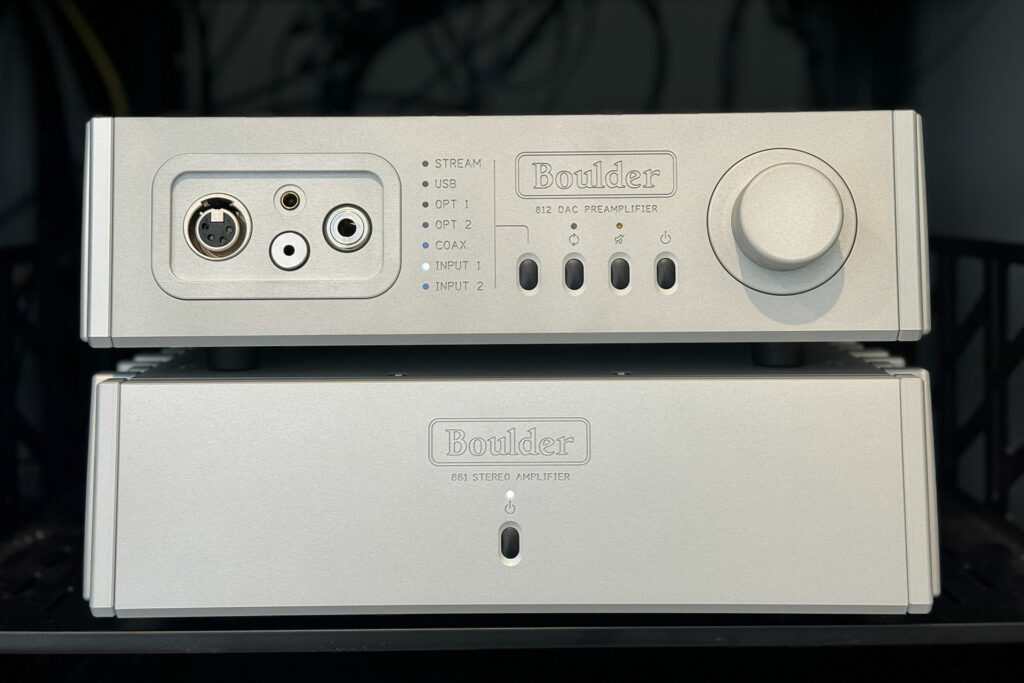When I think of badass audiophile power amps, there are a few brands that pop into my head, but at the front of the list is Boulder. Before the CEDIA trade show (mostly for AV custom installers) this past fall in Denver, I made a trip to see PS Audio, YG Acoustics and Boulder, which are all about an hour outside of Denver. I learned quite a bit on my trip. I want me some YG speakers, having seen how they use a CNC machine to make their metal drivers, without seams whatsoever, from a solid billet of aluminum. I also wanted me some Boulder gear, but with retail prices on their 2100 and 3000 series products costing more than my body parts chopped up and sold to science, that didn’t seem likely to ever end up in my equipment rack. That was, until Boulder introduced the 812 DAC/Preamp and 861 power amp – both priced at $9,250.
These smaller-than-standard-width form-factor audiophile components take industrial design cues from the sexy Boulder 866 integrated amp, and are physically about the most gorgeous audiophile components that I’ve ever touched/seen/experienced. When I say this: I’ve touched/seen/experienced pretty much every high-end audiophile brand or product out there, and these Boulder components are the finest that I’ve ever experienced.

The topic of this review is to take on the Boulder 812 DAC/Preamp, which can be a Roon endpoint, has a high-quality internal DAC (that can be bypassed), is a high-end headphone hub, and so much more. While not “cheap” in any sense of the term, the $9,250 price tag is more “aspirational,” in that if you ever were to save up your pennies – this is the type of product that you might just do it for. If you were to drop the better part of $10,000 on a DAC/Preamp, you have every right to have high expectations. Does the Boulder 812 live up to its billing? I am all over this one…
What Makes the Boulder 812 DAC/Preamp So Special?
- I can’t overemphasize how robust the Boulder 800 Series products are. I’ve seen them being made, as I have seen many other components in the audiophile business being made, and the Boulder products are next-level. The metalwork on the sides is artful, yet rock-solid. Everything feels right on the Boulder 812. The volume knob has that high-end preamp feel. The buttons are all the nicest you’ve ever pressed. This is a stunningly well-made high-end audio component.
- Boulder doesn’t say whose DAC chip that they use in the 812. This is an odd omission, as most audiophile companies proudly talk about whose chip they use, but Boulder customizes much about the DAC, because of their massive internal design capabilities. They do their own filtering (for DAC design not user “EQ”), so are not stuck with the stock options. The DAC in the Boulder 812 borrows a lot from the reference Boulder 2120 DAC, which is also the case with the Boulder integrated amp. For so many audiophiles, the internal DAC will be all they ever want/need delivered in this chassis, but for those looking to go to more exotic places, that option also exists.
- If you have your own high-end DAC, you can use the Boulder software to bypass the internal DAC. This is a very forward-thinking option on Boulder’s part, which allows for legacy DAC owners to be happy as well as to provide a potential upgrade path for people who will want to go to the next level after investing in a Boulder 812.
- The Boulder 812 is a killer headphone amp. This is rich-guy stuff, but I could see somebody buying a Boulder 812 just for a high-end headphone application for well-heeled audiophiles who want a little Boulder in their lives. The designers at Boulder put a cover on the many headphone jack options (1/8-inch, one-quarter-inch, 4-pin XLR and a Pentacon connector) that they have built into the Boulder 812. If you are into wired headphones, the Boulder 812 is going to appeal to you.
- The Boulder 812 is a capable endpoint that you can run your music on via software like Roon or platforms like AirPlay. We’ve got a whole story explaining everything about Roon for you coming soon, but one thing that not everybody knows about Roon is that the now-Harman-owned software doesn’t just run on its own. It needs a “core” or an endpoint (to use a nerdy computer industry term). I’ve reviewed a few of these components recently, including a low-cost but effective one from NAD. With the Boulder 812, you don’t need the fuss or muss or complications or expense. Everything that you need to start streaming is under the hood at $9,250. You can connect in other ways, too, such as Apple Airplay.
- There is an optional RF remote. My stereo preamp lives behind closed doors, but using sources that I can control the volume from my iPad (like a Bluesound Node or Bricasti M5), I didn’t really need the RF remote. The fact that it is RF is nice, in that IR repeaters are ugly and unreliable. I like that that Boulder resisted the urge to round the price up to $10,000 by throwing in the remote.
- Balanced analog (XLR) and digital inputs are waiting for your sources. COAX (RCA and S/PDIF), Ethernet, USB-B, and Optical are all available for your connectivity needs.
- “Made in America” is a little bit of an overblown issue in the audiophile hobby, but what is more important here is the insanely good internal hand-craftsmanship that goes into a product like the Boulder 812. I’ve seen the giant “pick and place” machines that allow for such sophisticated Boulder boards to be made in Colorado. I’ve seen the millions of parts that Boulder meticulously stores, many of which are made in their own CNC machines, like some of their speaker posts on their amps. You can spend more to get your preamp from more exotic locations, like Switzerland, Singapore or Spain, but let me tell you – you aren’t going to find more exacting, uber-high-end work done in another factory in the world. Boulder is Rolls-Royce stuff. Not S-Class Mercedes. Rolls.

Why Should You Care About the Boulder 812 DAC/Preamp?
The rise of the uber-high-end in the audiophile hobby has been well-documented in recent years. The reality is that the gross majority of audiophiles couldn’t ever justify or even dream of owning many of those products (think: WADAX, Gryphon, CH Precision, Constellation, D’Agostino, high-end T+A, Soulution and so many others). The Boulder 812 delivers the greatest hits from the new-school audiophile world at a price that, if you try really hard, you might just be able to afford.
You get so much of what Jeff and his team at Boulder have learned over 35 years in the 812 DAC/Preamp that the value is relatively high. The Boulder 812 also appeals to the all-in-one-box audiophile crowd a bit (the integrated amp really does that), but leaves a liberal upgrade path for you if you want some room to grow.

Some Things You Might Not Like About the Boulder 812 DAC/Preamp
- There are no unbalanced inputs. I can live without them, but some might have some issues here. One solution would be to use adaptors on one of the two balanced XLR inputs if you really needed an analog RCA input. The number of digital inputs is pretty generous, which is how the Boulder 812 is designed to meet your audiophile source needs.
- There is no phonostage in the Boulder 812. For me, this is a good thing, but with no RCA inputs, this could be a bit of a hang-up for other, more vinyl-oriented audiophiles. Boulder also isn’t the type of company that is going to throw a $195 phonostage into a product like the 812. If they are going to do a phonostage, they are going to do it right. For simplicity’s sake and relative to cable value, I would suggest you look for a phonostage with a balanced output if you want to run your turntable into a Boulder 812.
- AES-EBU is missing as a digital input for the internal DAC. I just finished doing a story about what digital cables we should all use in our audiophile systems, and my go-to choice (not always the best, but often) is AES-EBU. This robust and affordable XLR-looking digital connection isn’t available on the Boulder 812, which was a bit of a head-scratcher, but by no means the end of the world. A S/PDIF option like RCA/COAX can also be very good. Optical can be excellent, too, as an option to bring digital audio into your system.
- There is no room correction in the Boulder 812. My Anthem preamp at $4,000 has room correction. NAD’s new reference DAC/Preamp has room correction, too. This would run the price up, but room correction would be an asset, especially with the extremes that Boulder goes to when designing their products. I’ve heard digital room correction perform audiophile miracles, thus I am always looking for new solutions that can fix room issues.
Listening to the Boulder 812 DAC/Preamp…
My reference system for this review included a BlueSound Node, an Anthem STR stereo preamp, a Pass Labs XP-25 class-A amp, the Boulder 861 (the 812’s matching amp – review pending) and a pair of Bowers & Wilkins 802 D4 speakers. I used mostly WireWorld cables along with some from Monoprice.
One of the more popular but modern audiophile demo tracks that you will hear out and about is from Polish guitarist Marcin. His cover of Led Zeppelin’s “Kashmir” expands on what most of us thought could be done with an acoustic guitar (and a bass and piano, in case you missed it sonically, as the accompanying players aren’t featured much in the video). Marcin is part Eddie Van Halen, with his two-handed tapping on his acoustic guitar. He’s another part Alex Van Halen, with his percussive style of smacking/slapping his guitar as if it were a drum. How this guitar stays in tune is just beyond me. I heard this well-known but new-school demo track in Boulder’s totally awesome listening room, complete with their 3000 Series cost-no-object electronics and some big reference Focal speakers. It was heart-stoppingly good. What was impressive was how much of that beyond-expensive sound I was able to get in my room with the Boulder 812 DAC/Preamp in my system. The bass had a tightness to it that I only really heard with the Pass Labs XP-22 in my system, and that $10,000 preamp didn’t have a DAC built in, nor is it any sort of a digital endpoint. It is a great-sounding preamp, and so is the Boulder, as much of the listening that I did was with the Boulder DAC out of the mix. Not all, mind you, but I wanted to keep things as apples to apples as I could in this review, which was challenging but doable.
Credit for this next demo must go to acoustician Bob Hodas, who worked with the mastering engineer helping him tune his studio. “Hella Good” from No Doubt is a way-better-than expected demo for subwoofers and electronics alike. The palpability of the bass is just addictive with the Boulder 812 in the mix. The processed bass is low, tight and engaging. The production effects (also seemingly computer-generated) dance in the air above and outside the speakers, while Gwen Stefani’s voice is Rock Steady, if you will.
With the Boulder 812 DAC/Preamp in my reference audiophile system, I found myself listening to more and more classic progressive rock. The sound was so engaging that taking a sonic trip like “Echoes” from Pink Floyd’s trippy but excellent Meddle album is a good example. We are talking about 23:30 of thematic, dramatic and out-there, spacy jams. On the Boulder 812 (with the DAC engaged), you hear the resolution of the keyboard sound, which has a water droplet effect that is out there. As with The Wall, there are recurring musical themes that get revisited and recycled on this deep track. Forget FM radio, because “Echoes” is for people who will patiently sit down to listen to an entire album side, like us audiophiles. More than normal, I found myself humming along to the chorus of this song, and wanting to play it in its entirety, night-in and night-out. The Marcin track is more new-school and has a lot of attack, which sounds great with a Boulder front end, but more aged, classic jams like “Echoes” can come across as equally engaging.
Will the Boulder 812 DAC/Preamp Hold Its Value?
Boulder gear almost never comes up on the used market, so when it does, it gets snapped up quickly. This is not just a true Boulder component, but one that people can dream of owning, thus there will be lots and lots of music lovers looking to own such an audiophile gem. Like a few of the tastier components that I have sold over the years, I would expect a lot of demand (bordering on a feeding frenzy) for a Boulder 812 if one were to come on the used market. The high-end headphone folks would want such a component as well, which adds even more demand.
Simply put, I don’t think you have a thing to worry about with value when it comes to an 800 Series Boulder product like the 812 DAC/Preamp.

What is the Competition for the Boulder 812 DAC/Preamp?
Classe’ Delta PRE at $12,000 comes to mind as competition. This is a more expensive DAC preamp that has comparable build quality and very high-end features. I like that the Classe is a full-width component, versus the narrower Boulder 812. The Classe preamp doesn’t have room correction, but it has tone controls. The Classe preamp also takes HDMI inputs, which is really sexy. Sonically, both are pretty neutral preamps, which is what I expect at these prices. I don’t need a preamp adding in a “house sound,” and neither the Classe Delta PRE nor the Boulder 812 do that, thankfully.
In terms of resolution, the $10,000 Pass Labs XP-22, designed by Wayne Colburn, was the preamp that got away for me. I lent it to Greg Handy (who has the lower Pass Labs preamp, the XP-12), and he also fell in love with the detailed and nuanced sound of the Pass Labs, and he bought it. (Damn it, but they will make more.) The Boulder 812 does way more than the Pass Labs XP-22 for a little less money. Where they are comparable is in terms of overall resolution of details, because both preamps are excellent. I might give a slight nod to the Pass Labs in this category, but both sound very good. The best way to find out just how good is to spend a few days getting used to the Boulder 812, and then take it out of your system. I did that and I was bummed, as it is easy to get used to a stereo preamp that is this resolved, detailed and musically engaging.

Final Thoughts on the Boulder 812 DAC/Preamp…
Car analogies are massively clichéd in audiophile publishing. I’ve asked my staff to try to not use them anymore. So, of course, what am I about to do? Let me compare the Boulder 812 to an exotic car. I already made a Rolls-Royce analogy earlier, and I stick by that, but the 800 Series by Boulder is a game-changer for the high end, in that you can get so much of what is found in uber-expensive Boulder gear all wrapped up in one chassis with the Boulder 812 DAC/Preamp. The Boulder 812 is as if Ferrari came out with a Corvette killer at, say, $75,000 grand. It might not have a V12 power plant under the hood, but there would be much to like about such a car, and the fact that people could aspirationally afford to hire it would make it wildly popular with collectors and exotic car enthusiasts alike. The Boulder 812 DAC/Preamp feels like that to me, as the idea of owning Boulder gear for under $10,000 just seemed like a pipe dream. That is, until now.
Overall control, tight bass and resolution are all notes that I have etched down on my legal pad, and they are all accurate when describing the Boulder 812. The connectivity options and having an eye on audio’s digital future also makes the Boulder 812 appealing to many an audiophile. I don’t think that I’ve ever suggested that people go to visit an audio company, but what I saw at Boulder last fall was really eye- (and ear-) opening. Boulder builds audio equipment like no other company out there. They are fabulously audiophile extremists and rightfully refuse to apologize for it.
I am not the only fanboy for Boulder on staff and for all the right reasons. Now there is a chance that some of us might be able to own some Boulder gear if we save our pennies carefully, and that might be the most exciting part of whole experience with the Boulder 812 DAC/Preamp.




Let’s face it: most of us invest in high-end audio gear to escape drama, not invite it in. But what happens when your most prized possession—the Boulder 812—starts behaving like a girlfriend with borderline personality disorder? You think I’m joking? Let me walk you through it.
1. Idealization and Devaluation: “You’re the best! Wait… you’re useless!”
When you first power up the Boulder 812, it’s pure magic. Every note is pristine, the dynamics are godlike, and you wonder how you ever lived without it. That’s idealization.
Then comes a 3-hour power outage. The batteries are drained. You reboot… and suddenly, it’s acting up. Won’t connect right. Refuses to stabilize. Starts throwing digital tantrums. You try to love it again, but it’s cold. That’s devaluation.
2. Fear of Abandonment: “Don’t you dare unplug me!”
Borderline personalities often fear being left alone. Sound familiar?
Unplug the Boulder 812 from a clean power source, and it loses its mind. Forget to use a UPS or your new Inverex balcony inverter, and you’ll return to a device that’s sulking in silent protest, requiring a dozen reboots just to behave again. Classic emotional dysregulation.
3. Black-and-White Thinking: “I’m either in reference mode… or I’m nothing.”
There’s no middle ground. Either everything in the signal chain is perfect—power, cables, grounding—or the Boulder 812 decides it’s not performing at all.
Remind you of someone who either adores you or acts like you never existed?
4. The Reset Button: Emotional Amnesia in Silicon Form
One emotional episode—er, power glitch—and the Boulder resets itself like it forgot all the progress you made in your last five therapy sessions together. Sound signature? Gone. Headphone settings? Wiped. You’re starting from scratch like it’s your first date all over again.
5. The Need for Validation: “Only Transparent Reference cables make me feel whole.”
A BPD-afflicted girlfriend might need constant reassurance. The Boulder 812? Only functions optimally when paired with $5,000 power cords, a Nordost feeding tube, and an external clock chain worthy of a NASA satellite. Coincidence? I think not.
Conclusion: Love It, But Handle With Care
The Boulder 812 is still one of the finest headphone amps ever built. But treat it wrong—cut off its power supply, neglect its emotional needs—and it’ll make you pay for it. Just like that ex you still dream about at 2 AM.
So install that Inverex inverter. Whisper sweet nothings through your XLR cables. And remember: with great sonic power comes great emotional instability.
You need to see a shrink man!!! 🙂
Guess what little man, I am the shrink so let me ask you this question: how much did they pay you to write an article like this? Or did they give you a stash of weed or coke which you were high on when you sang praises of this cranky equipment. I’d be happy to take you in for a counseling 🙂